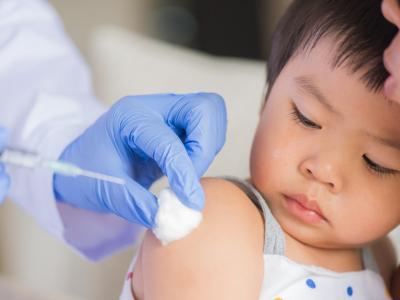Large study shows no association between Tdap and autism
A new study based on 80,000 children shows no association between prenatal Tdap vaccination (tetanus, diphtheria, and acellular pertussis) and autism spectrum disorder (ASD). The study is published in Pediatrics.
A research group at Kaiser Permanente conducted the study over a 4-year period from 2011 through 2014. ASD was diagnosed in 1,341 (1.6%) children in the study, comparable to the US autism rate of 1.7%. The incidence rate was 3.78 per 1,000 person years in the Tdap exposed group, and 4.05 per 1,000 person years in the unexposed group (hazard ratio: 0.98, 95% confidence interval: 0.88–1.09).
"Researchers have found infections during pregnancy (eg, rubella and influenza), including prolonged episodes of fever to increase autism risk, hypothesizing that maternal infections, cytokine responses, and proinflammatory pathways are likely to alter fetal brain development," the authors concluded. "Our results potentially indicate that the maternal Tdap vaccine affects immune trajectories protecting infants against infections that would otherwise lead to neurodevelopmental alterations."
Maternal Tdap vaccination coverage varied during the study period, from 26% in the 2012 birth cohort to 79% in the 2014 birth cohort. Prenatal Tdap vaccination is recommended as infants are the group at the highest risk for complications during pertussis infections.
Hung Fu Tseng, PhD, the study's senior author, said in a Kaiser Permanente press release given the increasing practice of vaccinating pregnant women with Tdap, it was important to address concerns about the link between maternal vaccination and development of ASD. "We hope that our findings reassure parents that Tdap vaccination during pregnancy was not associated with autism in children."
Aug 13 Kaiser Permanente press release
Aug 13 Pediatrics study
Study: Rotavirus vaccine should remain top priority to fight infant mortality
The rotavirus vaccine is a key tool in reducing global childhood mortality from diarrhea, according to a new global burden of disease study published in JAMA Pediatrics.
The study measured rotavirus data from 2016 in an effort to understand the extent of rotavirus cases and determine how effective the vaccine was in preventing morbidity and mortality among children under the age of 5.
According to the study, 27.8% of children younger than 5 years were vaccinated against rotavirus in 2016, with most rotavirus deaths occurring in sub-Saharan Africa, or other regions where routine vaccination was not yet practiced. Globally, diarrhea is the fourth leading cause of death in children worldwide, and rotavirus causes about 30% of all diarrhea cases in children.
Based on data from reporting countries, researchers said there were 128,500 deaths and 258,173,300 episodes of rotavirus-linked diarrhea among children younger than 5 years in 2016. The rotavirus vaccine is estimated to have averted approximately 28,000 deaths in 2016, and approximately 83,200 more children could have been saved if they had received the vaccine.
"These findings call for renewed efforts to prevent rotavirus infection through in- creased efforts to improve vaccination coverage, water and sanitation, and access to and quality of medical care," the authors concluded.
Aug 13 JAMA Pediatr study
Legionellosis outbreaks occurring earlier in the year as cases increase
Legionellosis outbreaks are on the rise in the United States, and they may be occurring earlier in the year. That's the takeaway from a new Epidemiology & Infection study based on data from the Centers for Disease Control and Prevention (CDC) and the Centers for Medicaid and Medicare Services (CMS).
To conduct the study, researchers looked at CDC reports of legionellosis from 1993 to 2015, and CMS medical claims from 1997 to 2006. Previous studies have described the increase in legionellosis as being due to increased reporting, aging infrastructure, and an aging population, which is more prone to infection.
After 2003, cases skyrocketed, with the CDC reporting a 300% increase in case counts from 2000 to 2014. Monthly counts also shifted; before 2003 mid-September (9.676 ± 0.164 months) saw the most number of cases reported, and after 2003, cases increasingly were recorded in mid-August (8.452 ± 0.042 months).
"The observed shift in peak timing could be related to environmental drivers and summer travel," the authors said.
Approximately 9% of legionellosis cases, caused by waterborne Legionella bacteria, are fatal and 40% require intensive care.
Aug 13 Epidemiol Infect study











